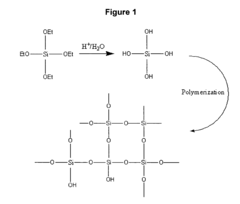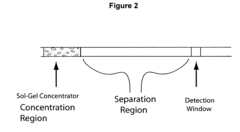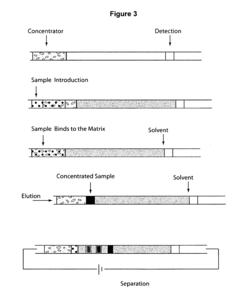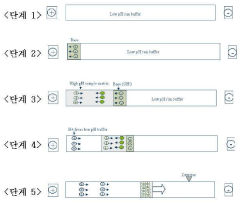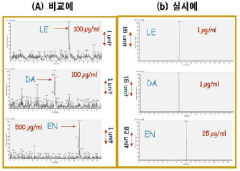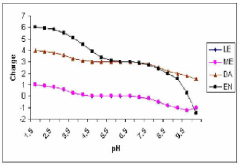How to Improve Gel Electrophoresis Sensitivity?
JUN 30, 20259 MIN READ
Generate Your Research Report Instantly with AI Agent
Patsnap Eureka helps you evaluate technical feasibility & market potential.
Gel Electrophoresis Sensitivity Background and Objectives
Gel electrophoresis has been a cornerstone technique in molecular biology since its inception in the 1960s. This method, which separates molecules based on their size and electrical charge, has proven invaluable in various applications, from DNA sequencing to protein analysis. However, as scientific research advances, there is an increasing demand for higher sensitivity in gel electrophoresis to detect and analyze smaller quantities of biomolecules.
The primary objective of improving gel electrophoresis sensitivity is to enhance the detection limits of this widely used technique. This goal is driven by the need to analyze minute samples, such as those obtained from single-cell studies or forensic investigations. Increased sensitivity would also allow for the detection of low-abundance proteins and nucleic acids, which are often crucial in understanding complex biological processes and disease mechanisms.
The evolution of gel electrophoresis sensitivity has been closely tied to advancements in detection methods and gel composition. Early techniques relied on visual inspection of stained gels, which limited sensitivity. The introduction of fluorescent dyes and laser-based detection systems marked significant progress, allowing for the detection of nanogram quantities of DNA. However, the current frontier lies in pushing these limits even further, aiming for picogram or even femtogram detection capabilities.
Improving gel electrophoresis sensitivity involves addressing several key aspects of the technique. These include optimizing gel composition to enhance resolution and reduce background noise, developing more sensitive staining and detection methods, and refining sample preparation techniques to maximize the concentration of target molecules. Additionally, there is a focus on integrating gel electrophoresis with other analytical techniques to create more powerful hybrid methods.
The quest for higher sensitivity in gel electrophoresis is not merely an academic pursuit but has far-reaching implications across various fields. In medical diagnostics, increased sensitivity could lead to earlier disease detection and more accurate prognosis. In forensic science, it could allow for the analysis of trace evidence that was previously undetectable. In environmental monitoring, it could enable the detection of low-level contaminants or rare species from minimal sample volumes.
As we explore ways to improve gel electrophoresis sensitivity, it is crucial to consider the balance between sensitivity and other important factors such as reproducibility, cost-effectiveness, and ease of use. The ultimate goal is to develop techniques that not only push the boundaries of detection limits but also remain practical and accessible for widespread use in research and clinical settings.
The primary objective of improving gel electrophoresis sensitivity is to enhance the detection limits of this widely used technique. This goal is driven by the need to analyze minute samples, such as those obtained from single-cell studies or forensic investigations. Increased sensitivity would also allow for the detection of low-abundance proteins and nucleic acids, which are often crucial in understanding complex biological processes and disease mechanisms.
The evolution of gel electrophoresis sensitivity has been closely tied to advancements in detection methods and gel composition. Early techniques relied on visual inspection of stained gels, which limited sensitivity. The introduction of fluorescent dyes and laser-based detection systems marked significant progress, allowing for the detection of nanogram quantities of DNA. However, the current frontier lies in pushing these limits even further, aiming for picogram or even femtogram detection capabilities.
Improving gel electrophoresis sensitivity involves addressing several key aspects of the technique. These include optimizing gel composition to enhance resolution and reduce background noise, developing more sensitive staining and detection methods, and refining sample preparation techniques to maximize the concentration of target molecules. Additionally, there is a focus on integrating gel electrophoresis with other analytical techniques to create more powerful hybrid methods.
The quest for higher sensitivity in gel electrophoresis is not merely an academic pursuit but has far-reaching implications across various fields. In medical diagnostics, increased sensitivity could lead to earlier disease detection and more accurate prognosis. In forensic science, it could allow for the analysis of trace evidence that was previously undetectable. In environmental monitoring, it could enable the detection of low-level contaminants or rare species from minimal sample volumes.
As we explore ways to improve gel electrophoresis sensitivity, it is crucial to consider the balance between sensitivity and other important factors such as reproducibility, cost-effectiveness, and ease of use. The ultimate goal is to develop techniques that not only push the boundaries of detection limits but also remain practical and accessible for widespread use in research and clinical settings.
Market Demand for High-Sensitivity Gel Electrophoresis
The market demand for high-sensitivity gel electrophoresis has been steadily increasing in recent years, driven by advancements in molecular biology, genomics, and proteomics research. This growing demand is primarily fueled by the need for more precise and sensitive detection of nucleic acids and proteins in various fields, including medical diagnostics, forensic science, and pharmaceutical development.
In the medical diagnostics sector, the rising prevalence of genetic disorders and infectious diseases has created a significant market for high-sensitivity gel electrophoresis techniques. These methods allow for the detection of low-abundance biomarkers and genetic mutations, enabling earlier and more accurate disease diagnosis. The global molecular diagnostics market, which heavily relies on gel electrophoresis, is projected to grow substantially in the coming years.
The pharmaceutical and biotechnology industries also contribute significantly to the demand for improved gel electrophoresis sensitivity. As drug discovery processes become more complex and targeted, there is an increasing need for highly sensitive analytical tools to identify and characterize potential drug candidates. High-sensitivity gel electrophoresis plays a crucial role in protein characterization, quality control, and purity assessment of biopharmaceuticals.
Academic and research institutions represent another major market segment driving the demand for enhanced gel electrophoresis sensitivity. As researchers delve deeper into understanding cellular processes and genetic mechanisms, they require more sensitive tools to detect and analyze minute quantities of biomolecules. This has led to a growing interest in developing and adopting high-sensitivity gel electrophoresis techniques in research laboratories worldwide.
The forensic science field has also seen an increased demand for high-sensitivity gel electrophoresis. As law enforcement agencies and forensic laboratories strive to solve cold cases and analyze degraded DNA samples, there is a pressing need for more sensitive and reliable analytical methods. Improved gel electrophoresis sensitivity can potentially revolutionize forensic DNA analysis, allowing for the detection of trace amounts of genetic material from crime scenes.
Environmental monitoring and food safety sectors are emerging markets for high-sensitivity gel electrophoresis. These industries require advanced analytical tools to detect contaminants, pathogens, and genetically modified organisms in environmental samples and food products. The ability to identify trace amounts of these substances is crucial for ensuring public health and safety, driving the demand for more sensitive electrophoresis techniques.
As the global biotechnology and life sciences markets continue to expand, the demand for high-sensitivity gel electrophoresis is expected to grow correspondingly. This trend is further supported by the increasing focus on personalized medicine, which requires highly sensitive and specific analytical tools for genetic profiling and biomarker detection. The market potential for improved gel electrophoresis sensitivity is substantial, with opportunities for innovation in both equipment and consumables.
In the medical diagnostics sector, the rising prevalence of genetic disorders and infectious diseases has created a significant market for high-sensitivity gel electrophoresis techniques. These methods allow for the detection of low-abundance biomarkers and genetic mutations, enabling earlier and more accurate disease diagnosis. The global molecular diagnostics market, which heavily relies on gel electrophoresis, is projected to grow substantially in the coming years.
The pharmaceutical and biotechnology industries also contribute significantly to the demand for improved gel electrophoresis sensitivity. As drug discovery processes become more complex and targeted, there is an increasing need for highly sensitive analytical tools to identify and characterize potential drug candidates. High-sensitivity gel electrophoresis plays a crucial role in protein characterization, quality control, and purity assessment of biopharmaceuticals.
Academic and research institutions represent another major market segment driving the demand for enhanced gel electrophoresis sensitivity. As researchers delve deeper into understanding cellular processes and genetic mechanisms, they require more sensitive tools to detect and analyze minute quantities of biomolecules. This has led to a growing interest in developing and adopting high-sensitivity gel electrophoresis techniques in research laboratories worldwide.
The forensic science field has also seen an increased demand for high-sensitivity gel electrophoresis. As law enforcement agencies and forensic laboratories strive to solve cold cases and analyze degraded DNA samples, there is a pressing need for more sensitive and reliable analytical methods. Improved gel electrophoresis sensitivity can potentially revolutionize forensic DNA analysis, allowing for the detection of trace amounts of genetic material from crime scenes.
Environmental monitoring and food safety sectors are emerging markets for high-sensitivity gel electrophoresis. These industries require advanced analytical tools to detect contaminants, pathogens, and genetically modified organisms in environmental samples and food products. The ability to identify trace amounts of these substances is crucial for ensuring public health and safety, driving the demand for more sensitive electrophoresis techniques.
As the global biotechnology and life sciences markets continue to expand, the demand for high-sensitivity gel electrophoresis is expected to grow correspondingly. This trend is further supported by the increasing focus on personalized medicine, which requires highly sensitive and specific analytical tools for genetic profiling and biomarker detection. The market potential for improved gel electrophoresis sensitivity is substantial, with opportunities for innovation in both equipment and consumables.
Current Limitations in Gel Electrophoresis Sensitivity
Gel electrophoresis is a widely used technique in molecular biology for separating and analyzing DNA, RNA, and proteins. However, despite its widespread application, the method faces several limitations in terms of sensitivity. One of the primary challenges is the detection of low-abundance molecules, particularly when dealing with complex biological samples.
The current detection limits of conventional gel electrophoresis techniques often fall short when analyzing trace amounts of nucleic acids or proteins. This limitation becomes particularly problematic in fields such as forensics, diagnostics, and environmental monitoring, where the ability to detect minute quantities of biomolecules is crucial.
Another significant limitation is the interference caused by background noise and non-specific signals. This issue can mask the presence of low-abundance targets, leading to false negatives or misinterpretation of results. The problem is exacerbated when working with samples containing a high concentration of contaminants or interfering substances.
The resolution of gel electrophoresis also poses a challenge, especially when separating molecules with similar molecular weights or charge-to-mass ratios. This limitation can result in overlapping bands or poor separation of closely related species, making it difficult to accurately identify and quantify specific targets.
Staining methods used in gel electrophoresis also contribute to sensitivity limitations. Traditional staining techniques, such as ethidium bromide for nucleic acids or Coomassie blue for proteins, may not provide sufficient sensitivity for detecting low-abundance molecules. While more sensitive fluorescent dyes are available, they often come with their own set of challenges, including photobleaching and high background fluorescence.
The loading capacity of gels presents another constraint on sensitivity. Overloading samples to detect trace amounts of target molecules can lead to poor resolution and band distortion, while underloading may result in signals below the detection threshold.
Electrophoresis run time and conditions also impact sensitivity. Longer run times may lead to band diffusion and loss of resolution, while shorter runs may not provide adequate separation. Optimizing these parameters for each specific application can be time-consuming and may require extensive trial and error.
Lastly, the inherent limitations of visual or densitometric analysis of gel images can hinder the accurate quantification of low-abundance molecules. The dynamic range of imaging systems and the subjectivity in interpreting faint bands can lead to inconsistencies in data analysis and reduced sensitivity.
Addressing these limitations is crucial for advancing the capabilities of gel electrophoresis and expanding its applications in various fields of molecular biology and biotechnology. Improving sensitivity would enable researchers to detect and analyze previously undetectable molecules, potentially leading to breakthroughs in areas such as early disease diagnosis, environmental monitoring, and fundamental biological research.
The current detection limits of conventional gel electrophoresis techniques often fall short when analyzing trace amounts of nucleic acids or proteins. This limitation becomes particularly problematic in fields such as forensics, diagnostics, and environmental monitoring, where the ability to detect minute quantities of biomolecules is crucial.
Another significant limitation is the interference caused by background noise and non-specific signals. This issue can mask the presence of low-abundance targets, leading to false negatives or misinterpretation of results. The problem is exacerbated when working with samples containing a high concentration of contaminants or interfering substances.
The resolution of gel electrophoresis also poses a challenge, especially when separating molecules with similar molecular weights or charge-to-mass ratios. This limitation can result in overlapping bands or poor separation of closely related species, making it difficult to accurately identify and quantify specific targets.
Staining methods used in gel electrophoresis also contribute to sensitivity limitations. Traditional staining techniques, such as ethidium bromide for nucleic acids or Coomassie blue for proteins, may not provide sufficient sensitivity for detecting low-abundance molecules. While more sensitive fluorescent dyes are available, they often come with their own set of challenges, including photobleaching and high background fluorescence.
The loading capacity of gels presents another constraint on sensitivity. Overloading samples to detect trace amounts of target molecules can lead to poor resolution and band distortion, while underloading may result in signals below the detection threshold.
Electrophoresis run time and conditions also impact sensitivity. Longer run times may lead to band diffusion and loss of resolution, while shorter runs may not provide adequate separation. Optimizing these parameters for each specific application can be time-consuming and may require extensive trial and error.
Lastly, the inherent limitations of visual or densitometric analysis of gel images can hinder the accurate quantification of low-abundance molecules. The dynamic range of imaging systems and the subjectivity in interpreting faint bands can lead to inconsistencies in data analysis and reduced sensitivity.
Addressing these limitations is crucial for advancing the capabilities of gel electrophoresis and expanding its applications in various fields of molecular biology and biotechnology. Improving sensitivity would enable researchers to detect and analyze previously undetectable molecules, potentially leading to breakthroughs in areas such as early disease diagnosis, environmental monitoring, and fundamental biological research.
Existing Sensitivity Enhancement Methods
01 Improved detection sensitivity
Various techniques are employed to enhance the detection sensitivity of gel electrophoresis. These include optimizing buffer compositions, using specialized staining methods, and implementing advanced imaging systems. Such improvements allow for the detection of lower concentrations of analytes and enable the analysis of smaller sample volumes.- Improved detection sensitivity: Various techniques are employed to enhance the detection sensitivity of gel electrophoresis. These include optimizing buffer compositions, using specialized staining methods, and implementing advanced imaging systems. Such improvements allow for the detection of lower concentrations of analytes and enable more precise analysis of complex samples.
- Novel gel compositions: Development of new gel compositions aims to increase sensitivity and resolution in electrophoresis. These may include modified polyacrylamide formulations, composite gels incorporating nanoparticles, or temperature-responsive polymers. Such innovations can lead to improved separation of biomolecules and enhanced detection of low-abundance species.
- Microfluidic electrophoresis systems: Miniaturized electrophoresis platforms offer advantages in terms of sensitivity and sample consumption. These systems often integrate sample preparation, separation, and detection steps, allowing for improved sensitivity through reduced sample dilution and more efficient analyte capture.
- Enhanced detection methods: Advanced detection techniques are developed to increase the sensitivity of gel electrophoresis. These may include fluorescence-based methods, chemiluminescence, or electrochemical detection. Such approaches can significantly lower detection limits and expand the range of detectable analytes.
- Sample preparation and pre-concentration: Improved sample preparation methods and pre-concentration techniques are employed to enhance the sensitivity of gel electrophoresis. These may involve selective extraction, affinity-based enrichment, or on-gel concentration of analytes. Such approaches can effectively increase the concentration of target molecules, leading to improved detection sensitivity.
02 Novel gel compositions
Development of new gel compositions aims to increase the resolution and sensitivity of electrophoresis. These may include the use of composite materials, nanoparticles, or specialized polymers that enhance separation efficiency and improve the detection of low-abundance molecules.Expand Specific Solutions03 Miniaturization and microfluidic systems
Integration of gel electrophoresis into miniaturized and microfluidic platforms allows for increased sensitivity due to reduced sample volumes and improved heat dissipation. These systems often incorporate advanced detection methods and can be coupled with other analytical techniques for enhanced performance.Expand Specific Solutions04 Electrokinetic sample concentration
Techniques for concentrating samples prior to or during electrophoresis can significantly improve sensitivity. These methods may involve electrokinetic focusing, isotachophoresis, or other concentration mechanisms that allow for the analysis of dilute samples or trace analytes.Expand Specific Solutions05 Multi-dimensional separation techniques
Combining gel electrophoresis with other separation methods, such as isoelectric focusing or liquid chromatography, can enhance overall sensitivity and resolution. These multi-dimensional approaches allow for better separation of complex mixtures and improved detection of low-abundance components.Expand Specific Solutions
Key Players in Gel Electrophoresis Industry
The gel electrophoresis sensitivity improvement landscape is characterized by a mature market with steady growth. The technology is well-established, with ongoing incremental advancements. Key players like Life Technologies, Agilent Technologies, and Beckman Coulter dominate the market, offering comprehensive solutions. These companies continually invest in R&D to enhance sensitivity and resolution. Academic institutions such as the University of Michigan and Kyoto University contribute to fundamental research. The market is driven by increasing demand in genomics, proteomics, and diagnostics. Emerging trends include miniaturization, automation, and integration with other analytical techniques to further improve sensitivity and throughput.
Life Technologies Corp.
Technical Solution: Life Technologies (now part of Thermo Fisher Scientific) has made significant advancements in improving gel electrophoresis sensitivity. They have developed the Novex line of pre-cast gels, which offer high-resolution protein separation and are compatible with various staining methods for enhanced sensitivity[13]. Their SYBR Safe DNA gel stain provides sensitive detection of DNA with a lower mutagenicity risk compared to ethidium bromide[14]. Life Technologies has also introduced the iBind Western System, which automates the antibody binding steps in Western blotting, leading to more consistent and sensitive protein detection[15]. Additionally, they offer the Attune NxT Flow Cytometer, which, while not directly a gel electrophoresis technology, complements it by providing highly sensitive detection of fluorescently labeled biomolecules, enhancing overall experimental sensitivity[16].
Strengths: Comprehensive range of electrophoresis products, innovative staining and detection technologies, integration with other analytical platforms. Weaknesses: Some advanced systems may have a steep learning curve, potentially higher costs for cutting-edge technologies.
Agilent Technologies, Inc.
Technical Solution: Agilent Technologies has developed advanced gel electrophoresis systems that improve sensitivity through multiple innovations. Their 2100 Bioanalyzer system uses microfluidic technology to perform electrophoresis on a chip, allowing for analysis of DNA, RNA, and proteins with very small sample volumes (as low as 1 μL)[1]. This miniaturization improves sensitivity by concentrating samples. They have also introduced high-sensitivity DNA analysis kits that can detect DNA concentrations as low as 5 pg/μL[2]. Additionally, Agilent has developed pulsed-field gel electrophoresis (PFGE) systems that can separate large DNA fragments up to 10 Mb in size, enhancing resolution for genomic applications[3].
Strengths: Miniaturization technology, high-sensitivity kits, and ability to analyze various biomolecules. Weaknesses: Higher cost compared to traditional systems, may require specialized training for operation.
Innovative Approaches to Improve Sensitivity
Methods and apparatus for improving the sensitivity of capillary zone electrophoresis
PatentInactiveUS20070014699A1
Innovation
- A sol-gel concentrating device with a polymerized alkylsilicate gel matrix and chromatographic sorbent particles within a capillary tube or microchannel, allowing for step-wise incubation and solvent evaporation without destabilizing the monolith, enhancing analyte concentration and detection.
Method for enhancing the detection sensitivity of capillary electrophoresis using improved sample injection mode
PatentInactiveKR1020100024107A
Innovation
- A method involving the injection of a low pH running buffer, formation of a base region with a high pH base, injection of the sample, re-injection of the running buffer, and subsequent detection, which controls the sample width and concentration during electrophoresis.
Regulatory Considerations for Improved Sensitivity Methods
Improving the sensitivity of gel electrophoresis techniques requires careful consideration of regulatory frameworks to ensure compliance and maintain the integrity of scientific research. Regulatory bodies such as the Food and Drug Administration (FDA) and the European Medicines Agency (EMA) have established guidelines for the validation and implementation of analytical methods, including those used in gel electrophoresis.
One key regulatory consideration is the need for method validation. Researchers must demonstrate that their improved sensitivity methods are reliable, reproducible, and capable of detecting the intended analytes at the claimed levels of sensitivity. This typically involves conducting extensive validation studies, including assessments of linearity, precision, accuracy, and limits of detection and quantification.
Regulatory agencies also emphasize the importance of quality control measures. Laboratories implementing enhanced sensitivity methods must establish robust quality control procedures to ensure consistent performance and detect any deviations or errors in the analytical process. This may include the use of reference standards, control samples, and regular instrument calibration.
Data integrity is another critical regulatory concern. Improved sensitivity methods often generate large volumes of complex data, which must be securely stored, easily retrievable, and protected from unauthorized alterations. Regulatory bodies require laboratories to implement appropriate data management systems and maintain detailed records of all experimental procedures and results.
The use of novel reagents or materials to enhance gel electrophoresis sensitivity may require additional regulatory scrutiny. Researchers must provide evidence of the safety and efficacy of these new components, particularly if they are intended for use in clinical or diagnostic applications. This may involve toxicological studies and assessments of potential interference with other analytical processes.
Regulatory agencies also emphasize the need for proper training and qualification of personnel involved in implementing and using improved sensitivity methods. Laboratories must demonstrate that their staff possess the necessary skills and knowledge to perform these advanced techniques accurately and consistently.
For methods intended for clinical use, such as in diagnostic applications, regulatory requirements are particularly stringent. Developers of improved sensitivity gel electrophoresis techniques for clinical purposes must navigate complex approval processes, which may include clinical trials to demonstrate the method's diagnostic accuracy and clinical utility.
Lastly, regulatory bodies encourage ongoing monitoring and improvement of analytical methods. Laboratories implementing enhanced sensitivity techniques should establish procedures for periodic review and optimization of their methods, taking into account advances in technology and evolving regulatory guidelines.
One key regulatory consideration is the need for method validation. Researchers must demonstrate that their improved sensitivity methods are reliable, reproducible, and capable of detecting the intended analytes at the claimed levels of sensitivity. This typically involves conducting extensive validation studies, including assessments of linearity, precision, accuracy, and limits of detection and quantification.
Regulatory agencies also emphasize the importance of quality control measures. Laboratories implementing enhanced sensitivity methods must establish robust quality control procedures to ensure consistent performance and detect any deviations or errors in the analytical process. This may include the use of reference standards, control samples, and regular instrument calibration.
Data integrity is another critical regulatory concern. Improved sensitivity methods often generate large volumes of complex data, which must be securely stored, easily retrievable, and protected from unauthorized alterations. Regulatory bodies require laboratories to implement appropriate data management systems and maintain detailed records of all experimental procedures and results.
The use of novel reagents or materials to enhance gel electrophoresis sensitivity may require additional regulatory scrutiny. Researchers must provide evidence of the safety and efficacy of these new components, particularly if they are intended for use in clinical or diagnostic applications. This may involve toxicological studies and assessments of potential interference with other analytical processes.
Regulatory agencies also emphasize the need for proper training and qualification of personnel involved in implementing and using improved sensitivity methods. Laboratories must demonstrate that their staff possess the necessary skills and knowledge to perform these advanced techniques accurately and consistently.
For methods intended for clinical use, such as in diagnostic applications, regulatory requirements are particularly stringent. Developers of improved sensitivity gel electrophoresis techniques for clinical purposes must navigate complex approval processes, which may include clinical trials to demonstrate the method's diagnostic accuracy and clinical utility.
Lastly, regulatory bodies encourage ongoing monitoring and improvement of analytical methods. Laboratories implementing enhanced sensitivity techniques should establish procedures for periodic review and optimization of their methods, taking into account advances in technology and evolving regulatory guidelines.
Environmental Impact of Enhanced Gel Electrophoresis Techniques
The enhancement of gel electrophoresis sensitivity has led to significant improvements in molecular biology research and diagnostics. However, these advancements also bring potential environmental concerns that must be addressed. The increased sensitivity often requires the use of more potent and potentially harmful chemicals, which can have adverse effects on the environment if not properly managed.
One of the primary environmental concerns is the disposal of hazardous waste generated during enhanced gel electrophoresis procedures. Highly sensitive techniques may involve the use of toxic staining agents, such as ethidium bromide, which can pose risks to aquatic ecosystems if improperly discharged. Additionally, the increased use of acrylamide in high-resolution gels raises concerns about its potential to contaminate soil and water sources.
The production and disposal of plastic consumables associated with enhanced gel electrophoresis techniques also contribute to environmental impact. As sensitivity improves, there is often a corresponding increase in the use of disposable plastics, including gel trays, combs, and pipette tips. This surge in plastic waste can exacerbate existing environmental challenges related to plastic pollution.
Energy consumption is another factor to consider when evaluating the environmental impact of enhanced gel electrophoresis techniques. More sensitive methods may require longer run times or specialized equipment, leading to increased electricity usage. This, in turn, contributes to higher carbon emissions if the energy source is not renewable.
The use of rare earth elements in some advanced imaging systems for gel analysis presents another environmental concern. The mining and processing of these elements can have significant ecological impacts, including habitat destruction and water pollution. As the demand for more sensitive detection methods grows, so does the potential strain on these limited resources.
However, it is important to note that improvements in gel electrophoresis sensitivity can also have positive environmental implications. More sensitive techniques often require smaller sample sizes, which can reduce the overall consumption of reagents and biological materials. This reduction in material use can lead to decreased waste generation and lower environmental impact per experiment.
Furthermore, enhanced sensitivity can lead to more accurate and reliable results, potentially reducing the need for repeated experiments. This efficiency gain can translate to lower overall resource consumption and waste production in research laboratories and diagnostic facilities.
In conclusion, while enhanced gel electrophoresis techniques offer significant benefits to scientific research and medical diagnostics, their environmental impact must be carefully considered and managed. Balancing the advantages of improved sensitivity with responsible environmental practices is crucial for sustainable scientific progress.
One of the primary environmental concerns is the disposal of hazardous waste generated during enhanced gel electrophoresis procedures. Highly sensitive techniques may involve the use of toxic staining agents, such as ethidium bromide, which can pose risks to aquatic ecosystems if improperly discharged. Additionally, the increased use of acrylamide in high-resolution gels raises concerns about its potential to contaminate soil and water sources.
The production and disposal of plastic consumables associated with enhanced gel electrophoresis techniques also contribute to environmental impact. As sensitivity improves, there is often a corresponding increase in the use of disposable plastics, including gel trays, combs, and pipette tips. This surge in plastic waste can exacerbate existing environmental challenges related to plastic pollution.
Energy consumption is another factor to consider when evaluating the environmental impact of enhanced gel electrophoresis techniques. More sensitive methods may require longer run times or specialized equipment, leading to increased electricity usage. This, in turn, contributes to higher carbon emissions if the energy source is not renewable.
The use of rare earth elements in some advanced imaging systems for gel analysis presents another environmental concern. The mining and processing of these elements can have significant ecological impacts, including habitat destruction and water pollution. As the demand for more sensitive detection methods grows, so does the potential strain on these limited resources.
However, it is important to note that improvements in gel electrophoresis sensitivity can also have positive environmental implications. More sensitive techniques often require smaller sample sizes, which can reduce the overall consumption of reagents and biological materials. This reduction in material use can lead to decreased waste generation and lower environmental impact per experiment.
Furthermore, enhanced sensitivity can lead to more accurate and reliable results, potentially reducing the need for repeated experiments. This efficiency gain can translate to lower overall resource consumption and waste production in research laboratories and diagnostic facilities.
In conclusion, while enhanced gel electrophoresis techniques offer significant benefits to scientific research and medical diagnostics, their environmental impact must be carefully considered and managed. Balancing the advantages of improved sensitivity with responsible environmental practices is crucial for sustainable scientific progress.
Unlock deeper insights with Patsnap Eureka Quick Research — get a full tech report to explore trends and direct your research. Try now!
Generate Your Research Report Instantly with AI Agent
Supercharge your innovation with Patsnap Eureka AI Agent Platform!

